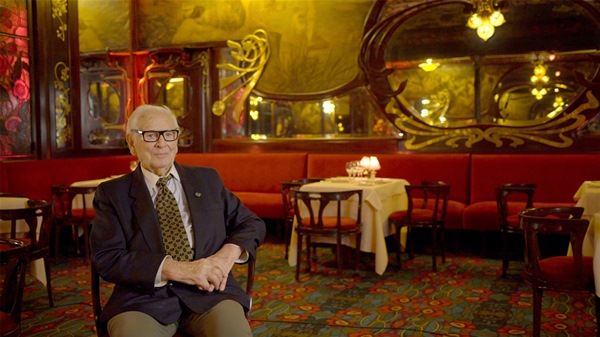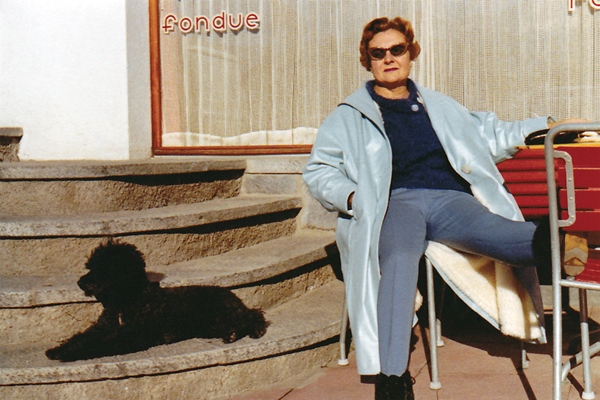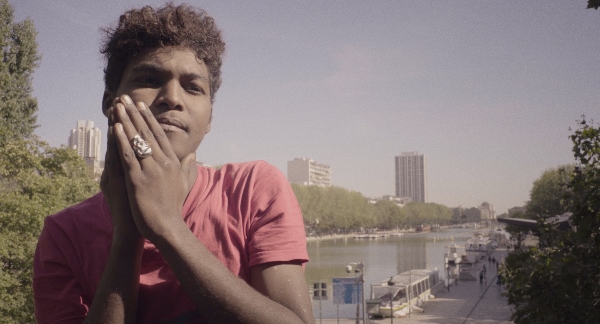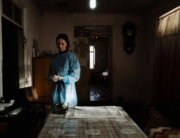
This year’s DOC NYC showcases uncompromising, persevering personalities: fashion visionaries, artistic innovators, and immigrants struggling for a foothold in the West. There’s even a musician who definitely did things his way. Without succumbing to feel-good treacle, these films offer up subjects for filmgoers to admire. Here are some of the festival’s standouts in rough order of merit.
House of Cardin
No one flatters its own like the fashion world, and numerous filmmakers have crafted a prototypical air-kiss fashion doc in recent years that goes something like this: Celebrities and experts laud an influential designer of yesteryear as the first to A) establish a global brand B) integrate the catwalk with nonwhite models C) bring fashion to the masses D) extend design flourishes far beyond mere clothes. P. David Ebersole and Todd Hughes’s documentary stakes the same familiar claims for design pioneer Pierre Cardin, but it beats other entries in the category by proving that the grandiose assertions may actually be true.
“He has a total, global, imperial vision,” gushes ebullient fashion designer Jean Paul Gaultier about Cardin. There is indeed an emperor-like aura attached to the flinty-eyed, forthright, and admittedly demanding creator, who never seems to have been waylaid by the distractions and demons that beset a Halston or Yves Saint Laurent. Cardin dressed the Beatles and put his name on thousands of items from perfume to cars to jet planes. The film covers his daring 1970s forays into fashion-starved China and Russia and his second careers as a theatrical impresario and restaurateur as the owner of Art Nouveau legend Maxim’s.
The filmmakers distinguish their work with stylish editing that lustrously celebrates Cardin’s colorful and ahead-of-their-time oeuvres. They also benefit from access to the great man himself, whom they catch in a few rare, sentimental moments. At 97, Cardin is still planning, creating, and building, and House of Cardin generously conveys that spirit of excitement.

Body of Truth
Evelyn Schels’s Body of Truth profiles four women artists focusing on the female body and reckoning with the dark historical forces of yesterday and today. This moody, proudly cerebral work underscores the similarities between these politically engaged creators while emphasizing them as individuals with their own vision.
Showing and talking about their work are controversial Serbian art star Marina Abramovic; photographer Katharina Sieverding, a member of Germany’s 1968 generation; Iranian photographer and filmmaker Shirin Neshat; and Israeli artist Sigalit Landau, currently creating installations in and around the Dead Sea. Much of their output reflects their and their families’ terrifying brushes with the 20th century’s dark catastrophes of communism, fascism, the Iranian revolution, and today’s tense Israel-Palestine standoff. All the artists take into account the strength and fragility of the female body, on its own or interacting with the other bodies and social constructs around it.
Shot in trendy cityscapes and monochrome interiors, the film sometimes flirts with art-world pretension, but interviews with its subjects offer bracing intimacy, honesty, and intelligence. Abramovic’s earthy charisma and blunt humor help explain her rise to celebrity. Sieverding may be the most leftist and political of the quartet, and the most outwardly reticent, so it’s a pleasure to hear her say “I’m ecstatic” upon seeing her huge public art project finally fall into place. Neshat addresses concepts of femininity and body awareness. Landau stands out with a modest, matter-of-fact take on her own deceptively sharp nature-based pieces.
Strikingly framed images and a dense, hard-hitting soundtrack further heighten the film’s impact, helping Body of Truth excel both as a provocative look at art and a frank portrait of questing, restless artists in search of their own version of the truth.

Madame
In gay Swiss filmmaker Stéphane Riethauser’s heart-warming movie, he finally comes out to his redoubtable grandmother. Along the way, though, he reveals something more universal and potent: the fear and hatred that lurk behind bourgeois propriety and the damage they can do. At least in its first half, Madame goes far beyond a standard autobiography to probe the stifling of human desires that can take place even in the most comfortable milieu.
Riethauser grew up in an affluent Geneva family, where, as the firstborn son, he was pampered and adored by his attractive parents. The adoration came at a price, though. Stéphane faced pressure to grow up into an exaggeratedly masculine take-charge type, a man on the go providing the required heirs—something he was clearly not destined to be or do.
Riethauser’s facility with language makes us see sex roles anew: a conception of women as mystical, helpless, and revered; men as controlling, aggressive and entitled, with shame and hate the fate of anyone who dares to move beyond the constructs. The film’s trove of books, home movies, and 1970s and ‘80s pop culture trappings vividly evoke the privileged but suffocating milieu in which he grew up, and his first-person narration sketches out the slow awakening and eventual withdrawal from that environment.
A parallel story unfolds of Riethauser’s grandmother Caroline, a successful corset mogul. Blunt, humorous, and vital, Caroline conceals pain beneath her bluff exterior without a trace of self-pity. Like her grandson, she found herself punished for wanting something other than what proper Swiss father figures decreed was her correct path in life. Riethauser has a stronger than usual awareness of male privilege, and his empathy for his grandmother is touching. For her part, she encourages him to lead the fullest life he can. “Go out and get the moon. The moon won’t come to you!”
Riethauser’s film traces his life journey to become a liberated man and gay activist in his forties. The coming out to his grandmother sounds a cozy note, but along the way, he eloquently exposes an apparatus of repression he was lucky—and young enough—to escape.

Paris Stalingrad
Hind Meddeb and Thim Naccache are mad as hell about the living conditions of refugees in Paris. The filmmakers spent the summer and fall of 2016 shooting the influx of newcomers who flooded the city’s Stalingrad neighborhood, capturing their desperation as they camped out on mattresses beneath underpasses and huddled in tents in makeshift camps. Intended as an indictment of France’s mistreatment of the less fortunate, the film concludes with a happy-ish ending that comes seemingly almost against the filmmakers’ will.
There’s no doubt whose side the directors are on. Their fly-on-the-wall camera pans along a line of refugees crowded outside a processing center, desperate to get in. A Frenchman tries to organize the line and manage the crush. “Aren’t you ashamed?” an indignant female voice rings out. He fixes the camera with a scornful gaze—he clearly feels no shame at all, madame. A few lone women acting independently frantically try to help the refugees obtain food, shelter, and documents, but they are clearly overmatched. Refugees shove and yell at the cops who dismantle their improvised dwellings.
It’s an untenable and dangerous situation, something that in their compassion for the dispossessed Meddeb and Naccache don’t really acknowledge. The directors show a more subtle, even-handed eye when they humanize their subjects and make us understand their ordeals. The filmmakers zero in on Souleymane, a young man from Darfur, whom they follow as he wanders the grim streets beyond touristic Paris in search of a place to sleep. Souleymane recounts his escape from a dangerous gold mine and recites dreamy poetry to keep himself sane.
Repetitive scenes of unrest at Stalingrad end in a showdown where police forcibly place refugees on a bus, a sinister action evoking ethnic cleansing. But as it turns out, Souleymane will end up in provincial Nancy with a job, papers, and a place to live. For all their rage over man’s inhumanity to man, Meddeb and Naccache don’t have much to say about this possibly best of all possible outcomes. It may be slow and harsh, but in this case the system worked. For an upbeat ending, it’s an oddly deflating one.

The Changin’ Times of Ike White
Blessed with musical talent and lean, dark-eyed good looks, handsome Ike White could have been a star. Too bad he was a con man. The Changin’ Times of Ike White tries to drum up a mystique around the ex-convict and would-be pop idol, but it leaves us with a tawdry life story well short of the glamour it aspires to.
White went to prison in 1974. Authorities said it was for murder, but he said it was for being in the wrong place in the wrong time in the wrong armed robbery. Ike’s girlfriend and later wife lobbied for Ike to record a 1976 album behind bars, Changin’ Times, with War producer Jerry Goldstein. The music they made together sounds like a cool funk artifact from the period—perhaps not the breakthrough work musician peers claim it is but a solid achievement nonetheless.
It’s when he got out of prison that White’s life really went downhill. Director Daniel Vernon and an ex-wife trace his trajectory backwards from a tragic event, but what they “discover” is a sad, familiar show business tale: a trail of changed names, dumped and beaten women, evictions, projects that didn’t pan out, and abandoned kids. The now grown children share the disappointment of their charismatic, charming father walking out of their lives, puzzlement and hurt plain on their faces.
Kitsch video from White’s cheesy 1980s Vegas act doesn’t do much to lighten the mood (or make a case for White as a creative genius). Changin’ Times wants to tell a tragic tale of a great talent thwarted. What we’re left with is a shadow—dark traces of a smiling trifler who not only messed up his own life but blighted many other lives along the way.






Leave A Comment